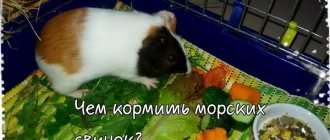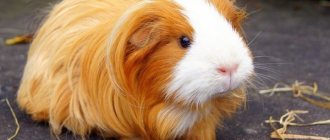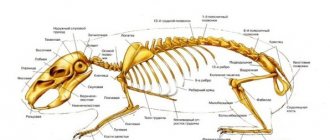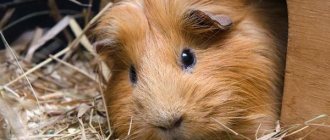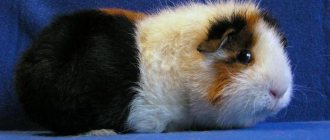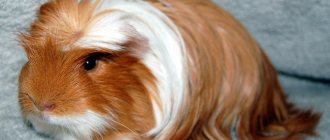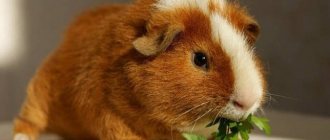The issue of proper nutrition is one of the main issues for all guinea pig owners. Therefore, before getting a rodent, it is important to get acquainted with a sample menu for it and decide on healthy and harmful foods.
Let's find out whether guinea pigs can eat grapes or persimmons, and what diet is preferable for these furry animals.
Basic diet
In the wild, rodents feed on tree bark and branches, leaves, berries and fruits. Fiber acts as the main source of vitamins and material that ensures the smooth functioning of the gastrointestinal tract. At home, the pig's diet is based on 3 main sources of vitamins and minerals:
- hay, meadow grass;
- vegetables and fruits;
- ready-made types of feed.
Important nuance! When choosing hay for your pet, you need to pay attention to its structure and color. Ideally, it should be soft and green. Pellet feed should be kept in the smallest quantities possible.
It is recommended to give your pet no more than 120 grams of vegetables and fruits per day. If the pet does not finish the food, it should be replaced with a fresh option. If the product rots or spoils, it can cause problems with the digestive system.
Can guinea pigs eat melon?
Melon is given to guinea pigs, but rarely and in small quantities. It contains vitamin C, important for animal health, as well as calcium and phosphorus. In addition to useful substances, melon contains a considerable amount of sugar, which is extremely dangerous for small pets. Sugar causes many health problems if consumed uncontrollably, frequently and in large quantities. One of the most dangerous diseases it leads to is diabetes.
Taking into account the pet's need for nutrients, a guinea pig can be given a piece of melon weighing up to 20-40 g - 2 times a month.
Do not forget that this delicacy should not be the only succulent food that day.
The daily diet includes at least 3-5 vegetables and fruits. The melon must be ripe, free of nitrates and washed. The pet is given a piece of melon, cut off along with the rind, if the fruit does not contain harmful substances and without the rind, if there are doubts about its quality.
In what cases should you not give watermelon and melon to guinea pigs?
Source
Vegetable menu
The main task of vitamin C in the rodent body is to control the functioning of connective and bone tissues. Animals have to look for it from external sources, since the animal body is not able to produce it in such quantities.
Pigs' favorites on the menu most often include apples, carrots and cucumbers. Vitamin C can enter the animal's body through raw food of plant origin. It is important to give them to your pet at least 1 teaspoon per day. Veterinarians also list the following as approved products:
- Zucchini is allowed due to its high content of minerals and pectins, which normalize the functioning of intestinal permeability.
- Carrots have a positive effect on the condition of the animal’s coat and skin, as well as visual and auditory function. You can give not only the fruit itself, but also well-washed tops. Due to the content of Vitamin A, urine may turn orange.
- Bell pepper can be given to animals only during the season, due to the fact that winter varieties are oversaturated with nitrates. Only sweet varieties are allowed to serve as food.
- Pumpkin is also given to the animal almost completely. And zinc contained in the seeds is a strong preventative against helminthiases.
- Cucumbers themselves are low in calories, safe and have the ability to help digest heavy fats.
- Fresh peas are also acceptable, but in small quantities. Despite the disapproval of veterinarians. Some food manufacturers add the essence of the fruit to their mixtures, despite the fact that they can cause a negative side reaction in the animal.
- Cabbage is also allowed, but subject to proper supervision. While it causes gas in some people, excessive use can be dangerous for pigs. It is worth introducing it into the diet gradually, observing the reaction of your friend.
- Rutabaga facilitates bowel movements and helps avoid constipation. Best suited for your pet's winter diet.
- Jerusalem artichoke can be given as a treat, strictly limiting its total amount in the animal’s diet. The root vegetable itself is the most dangerous; other parts of the plant can be given constantly.
The most undesirable products include:
- Tomatoes are especially considered dangerous when green. They contain solanine, in addition, the use of tops is also not recommended. Ripe tomatoes, due to the destruction of poisons, can be included in the diet in small quantities. If you overdo it, the animal may experience intestinal upset and problems with the gastrointestinal tract.
- Potatoes are prohibited due to starch and solanine.
- Melon has a risk of developing diabetes due to the abundance of sugars.
- Radish and radish oils can cause bloating.
- Beetroot has a stable effect and is not particularly recommended for pregnant females. Root vegetables and tops are recommended for healthy individuals in small quantities. After eating beets, the animal’s urine may temporarily acquire a red tint.
- Corn is prohibited for pigs; only tops are allowed. And grains contain a large amount of starch, which can cause obesity.
Is it possible to feed guinea pigs melon?
Among the recommendations for feeding the described animals are foods that must be included in the rodent’s diet, and those that are prohibited. There is also a list of ingredients that should be given to your pig with caution.
The menu must contain the following components:
Melon is included in the list of foods that can be given, but rarely. It contains vitamin C, calcium and phosphorus necessary for the animal’s body. 100 g of melon contains 30 mg of ascorbic acid, while a pig needs 10–15 mg per day. Calcium in pulp - 10 mg/100 g, phosphorus - 18 mg.
Effect on the body
Restrictions on eating melon are due to the fact that it contains a large amount of sugar. Due to the fact that this berry is very sweet, if eaten frequently it can lead to negative consequences for the animal’s body. One of the problems that uncontrolled and frequent consumption of melon can provoke is the development of diabetes.
How much can you give?
Vegetables and fruits should be fed to the rodent daily. The recommended daily intake is 80–120 g. Of course, you shouldn’t give just melon to your animal. Meals need to be balanced. A rodent's daily menu should include at least 3 different vegetables or fruits.
In general, the distribution of products in the daily menu should be as follows:
Allowed fruit menu products
Despite all the benefits of a fruit diet, fruit consumption by animals must be dosed. This restriction is introduced due to the high sugar content, which can cause diabetes or obesity. Despite the wide variety of fruits, the pig is allowed only apples in almost unlimited quantities. The seeds from the fruit should be removed, they contain dangerous poisons. Berries in diets are allowed only from the permitted list:
- Grapes contain a large amount of fiber, which has a beneficial effect on the functioning of the gastrointestinal tract.
- Watermelons can be given in the form of pulp. But they have a diuretic effect, so they should be dosed.
- Rowan contains healthy carotene, as well as vitamins C and P.
These types of berries are considered permitted, but there are also controversial fruits:
- A number of citrus fruits provoke irritation of the mucous membrane and can cause allergies.
- Strawberries are fraught with an excess of vitamin C. It can lead to ulcers and gastritis. In safe quantities, seasonal berries can be given no more than a couple of times a week.
- Although they can replenish glucose and fiber, they can also cause excess calories and lead to obesity. Their use should be kept to the minimum possible.
It is important to note that rodents are still herbivores. Meat and dairy products should be avoided in the diet.
Can guinea pigs eat melon?
This melon berry can be an extra treat for your guinea pig. After all, it contains a lot of water and a whole range of useful components. But when using it, one should not forget about the increased sweetness of this fruit, which can provoke the development of diabetes in the pet.
Useful properties of pumpkin
Melon is beneficial for guinea pigs when consumed in moderation. After all, this berry contains fiber, organic acids, pectins, mineral components, vitamins B, PP, A, E. And the high water content helps quench the animal’s thirst on hot days.
Impact on the rodent's body
Giving guinea pigs melon only when it is in season reduces the likelihood of it containing nitrates. Ripe juicy melon berries strengthen the pet's immunity, normalize the functioning of the digestive system and improve intestinal microflora.
And the vitamins and mineral components contained in it help the animal to be active.
Melon and babies
Only adult pets can be fed melon berries. It is not recommended to feed melon to babies, as their digestive system is not yet able to cope with such a load. Otherwise, this can lead to flatulence, diarrhea and negatively affect the health of animals.
Standards for use without harm to health
The permissible daily intake of melon is 40 g. But you need to start introducing melon into your pet’s diet with a small dosage, followed by monitoring the reaction of his body. If the product does not cause negative symptoms, then its mass fraction can be gradually increased.
You need to give melon to a rodent once a week.
What about the seeds and crusts?
Having clarified whether guinea pigs can eat melon, you should also know exactly how to give this fruit. Before feeding the melon berry, its peel should be washed well and blotted off the moisture with a paper towel. You can feed your pet the pulp along with the peel. But it’s better to remove the seeds. After all, they are high in calories. And this can cause obesity and diabetes in the rodent.
Melon can be given to guinea pigs in doses. This melon berry is not the main food and is not able to provide the animal with all the nutritional components. Therefore, you need to feed her little by little in the morning. This can be done only during the season of mass ripening of melons, so that they do not contain nitrates.
Solid food
Solid (roughage) food consists of grains, hay, and special food in granules, which is available in pet stores. You don’t have to give special food, but when there is no grass or hay, it is the best option. These animals love to eat this food, just as birds peck their favorite grains. Now you can buy ready-made feed in granules, intended specifically for these animals; these granules contain vitamin C. The feed contains this vitamin, it should not be stored for a long time, no more than three months. This food must be stored in a dry place, in tight packaging, otherwise it may become moldy and spoiled, becoming unsuitable for consumption.
Can rodents eat exotic fruits?
Guinea pigs are allowed to give bananas, grapes, and some types of imported fruits, but how much can be offered to a particular animal is determined by the doctor individually, after examining and weighing the animal.
This takes into account:
Exotic fruits can provide a complete diet for your pet, saturating it with essential vitamins and microelements, especially potassium (bananas), calcium and phosphorus (kiwi, persimmon, melons). With a lack of vitamin C, rodents sometimes experience paralysis. For an animal to be healthy, it needs 15 mg of vitamin C per 1 kg of live weight every day.
Can guinea pigs eat bananas?
Experienced breeders of domestic rodents advise including exotic delicacies in the animals' diet in the smallest quantities and as rarely as possible (1-2 times a week). The one-time norm for one animal is 1–2 pieces of banana, 5–10 g each. You can feed your guinea pig 1 small banana per day, provided that the pet is healthy and tolerates this type of treat well.
Such fruits require careful (preliminary) processing. A huge amount of pesticides accumulate on and inside banana peels. Therefore, unpeeled fruits should be washed in running water, doused with boiling water and only then peeled.
A guinea pig can have a banana, but not a banana peel. The peeled fruit contains a lot of useful fiber and vitamins. But due to repeated chemical processing of fruits, there is a high probability of some of the chemicals getting into the tissues of the fruit. Therefore, experts recommend including bananas in the diet of guinea pigs as rarely as possible. In addition, fruits contain a lot of sugar, which can cause problems with the digestive system in rodents.
Important! Most exotic fruits (pineapples, papaya, mango, guava) contain a lot of sucrose. Their presence in the diet of domestic rodents is extremely undesirable. Exceeding the norm of such products, as a rule, causes digestive disorders that are dangerous to health.
The fruits are extremely beneficial for guinea pigs. They contain a lot of folic acid, iron, calcium, magnesium, phosphorus, and vitamin E. Kiwi is included in the animals’ diet 1-2 times a month.
It is recommended to offer animals solid fruits, and not to allow the amount eaten to exceed the norm (1-2 quarters of a round piece per day). Kiwi is especially useful for female guinea pigs who are expecting offspring or feeding newborn babies.
Grape
For pet rodents, you should choose seedless varieties, such as sultanas. You can treat the animal with grapes no more than 1–2 times a month, in limited quantities (20–30 g per day). The reason is still the same - excess sucrose content.
The grapes should not be unripe or overripe. Feeding animals with rotting berries is completely unacceptable.
Interesting! Avocado fruits are toxic to guinea pigs. Eating them leads to prolonged diarrhea and digestive disorders.
Persimmon
Sometimes these fruits are called Chinese peaches; they contain a lot of fiber, a huge amount of vitamins, pectin, and iodine. It has been noticed that when they are eaten, the functioning of the digestive system is noticeably improved and immunity is increased.
Persimmon is very beneficial for guinea pigs. But you shouldn’t give them fruit often, so as not to provoke an increase in blood sugar. If an animal is prone to constipation, it is better to avoid persimmons in its diet.
The optimal number of treats per week is 2 times. You should give treats little by little and control the correct distribution of the amount of fruit between all neighbors in the cage.
Important! Persimmon is incompatible with milk and water.
Green food
This food must be given to your guinea pig, but you need to know what kind of greens you need to give your pet. The main herb is fresh grass from fields and meadows with medicinal and spicy herbs. You shouldn’t tear up greenery at the edge of the road, as many cars pass by and exhaust gases settle on the grass. It is not recommended to collect grass under trees either; birds like to sit on trees, and their droppings cause rotting of the greenery. Pigs love grass, it helps them always stay healthy. Greens contain many vitamins. Greenery includes not only field grass, but also that which a person eats. These animals love to eat: spinach, the stem and greens of dill, parsley, it’s worth giving a little, and lettuce and other greens.
Is it possible to give your pet watermelon?
Many pigs like bright and juicy watermelon. This product is not prohibited for consumption. In moderation, it can be included in the menu, but remember that the berry provokes a diuretic effect. It is allowed to put a piece in the feeder along with the crust. Watermelon seeds should not be given, they are too hard and large.
So, a guinea pig’s daily menu must include succulent food - fruits, vegetables, berries, herbs. Not all foods in these categories may be beneficial for your pet, so you should check the list of prohibited ingredients before putting any of them in the feeder. You can feed your pig melon and watermelon, but in small quantities and only during the picking season of these berries.
Source
Combined feeds
In order for the animal to receive enough nutrients, give it regularly green grass, fresh berries, fruits, vegetables, hay, all this is necessary for your animal. This is the best nutrition for your pet to provide at home. There are also different feeds with herbs and fruits for pigs. The feed also contains grains, dried fruits and honey. A guinea pig can eat only natural products; food is not mandatory in its diet, but many owners of these animals still buy that food. There are many advertisements for different foods, but you don’t need to feed your pet exclusively food.
You should not give your guinea pig food that contains:
- bone meal (in nature, guinea pigs do not consume animal products);
- nuts;
- corn based syrup;
- preservatives.
What fruits are good for a guinea pig?
Content
The issue of proper nutrition is one of the main issues for all guinea pig owners. Therefore, before getting a rodent, it is important to get acquainted with a sample menu for it and decide on healthy and harmful foods.
Let's find out whether guinea pigs can eat grapes or persimmons, and what diet is preferable for these furry animals.
Berries and fruits
Natural berries and fruits contain the bulk of the vitamins your guinea pig needs, not just the treats your guinea pig loves. Fruits are not forbidden to the animal; they can be included in the daily diet, the animal will choose what it likes more, and advice from a veterinarian on nutrition is also possible. Veterinarians do not recommend giving your guinea pig a lot of sweet fruits. They are more likely to have indigestion, which occurs more often in them than in other rodents. A large number of sweet tangerines, apples and pears can cause just such a disorder. Give tangerines to your pet with particular care. They are, of course, an essential source of vitamin C, which the pig's body does not produce, and citrus fruits are the main source. But tangerines are strong allergens. You can give a little, a slice every day and watch the behavior of the guinea pig to see if it has developed an allergy.
Is it possible to feed a guinea pig melon?
Guinea pigs are considered herbivores that love to eat plant foods. When keeping these pets, you need to provide proper balanced nutrition. This will allow them to quickly restore lost strength during activity and fully develop. However, not all plant foods are beneficial for the animal. Therefore, you should figure out whether guinea pigs can eat melon, because many owners prefer to pamper their rodents with this delicacy.
Water
Every animal needs water and the guinea pig is no exception, although some breeders think differently, thinking that if the animal eats a lot of green grass, then it does not have such a need for water. But this opinion is not correct. All pigs need water, especially in hot weather and also for pregnant and lactating females. Fresh water should always be provided. It is better not to give a mug a drinking bowl, the water in it quickly becomes not fresh; for water it is better to take bottles - drinking bowls.
When it's hot outside, you can give the animals an open shelf so they can dip their paws in it. This cools the animal's body.
Citrus fruits, pears, apples in the diet of guinea pigs
The basis of the daily menu for guinea pigs is cereals and fresh plant food. However, not all types of vegetables, fruits or berries are beneficial for these rodents.
Table 1. Forbidden foods
| Products | Herbs | Berries |
| Rhubarb, sorrel, chicken eggs, garlic, onions and green onions, sugar, milk, sweet cookies. | Leaves and stems of celandine, mint, fern, thyme, snowdrop, basil, foxglove, aloe, honeysuckle. | Plums, peaches, apricots, cherries. |
Interesting! Veterinarians advise adding spinach leaves, beet and radish tops, parsley, and dandelion leaves to the menu of pet rodents.
In order for animals to receive enough vitamins and microelements, they must eat at least 120 g of fresh fiber daily. Before giving vegetables or fruits to your pet, they must:
Important! Spoiled or rotting products should not be used to feed domestic rodents.
Citrus
The diet of guinea pigs includes 3 parts:
The body of furry pets does not know how to reproduce vitamin C on its own; it is “extracted” from food.
Zoological experts strongly advise against feeding guinea pigs citrus products regularly.
Important! Before giving fruit to animals, the fruits are freed from seeds and peel. The zest is strictly contraindicated for guinea pigs.
Some rodents are ready to treat themselves to juicy oranges or tangerines at least every day, but this should not be allowed. A healthy animal is allowed to eat a piece of orange, tangerine or grapefruit 1-2 times in 7-10 days.
Important! Citrus fruits should not be given to young pigs with an immature digestive system and to females during pregnancy or lactation.
Uncontrolled consumption of citrus fruits can cause serious health problems in animals. The most common of them are:
If you decide to pamper your guinea pig with tangerine, you can give it only 1 slice. If there are several individuals in one cage, it is necessary to carefully monitor that the more nimble pets do not eat someone else’s food. 1–2 hours after the meal, the remaining food is removed.
Interesting! The animals should be observed after feeding citrus fruits. If digestive problems occur, the treat should be excluded from the diet.
Pears
The leaves and young branches of pear trees are very useful for the health of rodents. The fruits themselves can be given to animals only occasionally, as a treat.
If you offer your guinea pig a pear, you need to give it water at the same time. High levels of sucrose in juicy fruits often provoke the development of diarrhea in rodents. To neutralize the adverse effects, you should reduce the concentration of sugar in the body of your furry pets and dilute the treat with water.
For guinea pigs, it is better to choose firm varieties of pears. The average norm per day is approximately 40–45 g. These fruits can be fed to rodents along with the peel. However, it is better to remove the seeds in advance to avoid complications with the digestive system.
Apples
These fruits are simply necessary for guinea pigs to maintain health and daily activity. Most animals prefer sweet varieties. The most useful fruits for rodents are Antonovka, Titovka, and Semerenko.
Fruits have a perfectly balanced ratio of fructose (80%) and sucrose (18%). In addition, they contain pectin, fiber, B vitamins, and beneficial minerals.
Interesting! If the apples are dried, they are soaked and boiled before feeding.
Pigs enjoy eating both fresh and dried apples. The fruits are first peeled and cut into small slices. The maximum amount of treats at one time for each animal is no more than 3 pieces.
What food is prohibited
Guinea pigs are not carnivores, they do not drink milk or eat meat products, they are true vegans.
When thinking about what to feed your pet at home, do not give him:
- porridge;
- dairy products, cheese and cottage cheese;
- meat and fish products;
- vegetable stew;
- eggplant;
- raw potatoes;
- night blindness;
- fern;
- sow thistle;
- wild rosemary;
- celandine;
- fighter.
You also shouldn’t give overripe or unripe fruits, vegetables, damp grains, old mixed feed; you also shouldn’t feed the rodent what you eat yourself every day. Do not give a lot of sorrel to your pet, it is not prohibited, but in small quantities.
The option is to give the animal store-bought food a couple of times a day, this is of course also an option, but how correct is it to feed the pig only this. This is suitable if the animal is not yours, and you were simply asked to look after the pet. But this is not the best option if you purposefully got yourself this pet. You should not care about the health and condition of your pet or how long your friend will live.
Organizing the diet of small pets
To keep your pet healthy and active, it needs a balanced diet. And food from the human table is in no way suitable for a guinea pig. After all, the digestive system of a rodent is structured differently. Any experiments can lead to a deterioration in his health. Therefore, before you find out whether guinea pigs can eat melon, you should clarify what is recommended to be given to the animal and what is prohibited.
Experts insist that this pet’s diet should include:
Hay is an ideal product for a rodent. Dried grass is not only a nutritious food, but also a product that helps to wear down teeth, which grow throughout the animal’s life. For hay, you cannot collect greens growing near highways, factories, or swampy areas. This is due to the fact that it has the ability to accumulate toxic substances. Therefore, it is better to give preference to grass growing in meadows, fields, and gardens. It needs to be dried for at least 1.5-2 months, and then it is recommended to store it in a dry room with low humidity so that it does not turn black or mold.
During the summer months, you should give your pets fresh greens, but with hay. Moreover, their mass fractions must be the same. Field and specially grown greens are suitable for feeding.
On a note! It is forbidden to feed rhubarb and sorrel to guinea pigs due to their high acid content.
This pet needs to be given food 2-3 times a day. But hay, as well as water, must always be in the cage. It is necessary to give juicy food in the morning, and dry food in the afternoon, because it takes more time to digest it. Ready-made food, which is sold in pet stores with three meals a day, should be given 1/3 tbsp. l., and with two meals a day - 1/2.
On a note! Meat, dairy products, and eggs are not digested by the rodent’s digestive system and can cause serious health complications.
Foods to Avoid
Avoid feeding your guinea pigs plants such as lily of the valley, wormwood, fern, chamomile, privet, ragwort, rhubarb, hellebore, wild celery, onion, belladonna, foxglove, iceberg lettuce and plants that grow from bulbs, as these are considered poisonous to guinea pigs. In addition, beans, popcorn, ice cream, sugary foods, chips, potatoes, meat, fish and cheese should be avoided. Don't feed too much dairy or caffeinated foods, including chocolate or lots of bread or cookies.
This animal cannot synthesize vitamin C and must obtain it from its diet. Typically, most dry foods are fortified with vitamin C. In addition to this, you can provide them with broccoli, apples, celery, spinach and orange fruits and vegetables that are rich in this vitamin. The second important thing to note is that guinea pigs react painfully to any sudden change in their diet. Therefore, it is better to introduce new foods into the diet slowly and gradually. You can also talk to your veterinarian and follow their advice. Finally, along with nutritious foods, give them fresh fresh water daily.
Keep cages neat and clean, replace soiled supplies regularly, and keep guinea pigs well-groomed and healthy.
Drinking regime
In addition to food, drinking regime is very important for the health of a guinea pig. There is an opinion that if a pet gets grass and vegetables, there is no need for water, but this is completely wrong.
Water must be present in large quantities. They need to install drinking bowls with a volume of at least 250 ml; there must be water in them at all times; it must be changed regularly.
Remember that if the female is pregnant, she needs even more water, also when feeding her cubs, so several drinking bowls are installed.
There are several rules that must be followed, these include:
- It is forbidden to give distilled water; it is completely purified and does not contain useful microelements and macroelements.
- You cannot drink water that is saturated with various minerals. An excess is just as dangerous as a deficiency, for example, calcium oversaturation leads to the formation of kidney stones.
- Vitamins and other medications should not be given with water.
- Untreated tap water contains chlorine and heavy metals that are dangerous to the animal; it must be filtered before giving it to the rodent.
- The most suitable is bottled water, which does not contain flavoring additives; pure spring water is also suitable.
- Pieces of food constantly get into the water, so it needs to be changed regularly.
- If you put water in an ordinary bowl, the guinea pig will often spill it, and in such a bowl it will become dirty faster; it is better to purchase a special drip-type drinker. But remember that the metal nozzle in such drinkers must be constantly cleaned; food particles accumulate in it and this is an excellent environment for the growth of bacteria.
If you follow simple rules, you can keep your pet safe. When creating a diet for a guinea pig, remember that the health of the animal depends on it, be careful, and do not try to treat the rodent to everything that you eat yourself, watermelon, melon, peaches, strawberries, be careful. Thinking that this is good, you can seriously harm him.
Nutrition for pregnant pigs and newborn piglets
Pregnant pets must eat well and of high quality. The diet of furry mothers should be rich in proteins and vitamins. It is useful to give pregnant females carrots, beets, and wheat sprouts. You can periodically add a little milk to the water. Rosehip infusion brings great benefits to the body of a pregnant pig.
If the female who gave birth does not have milk, then the owner will have to feed the cubs on his own using a syringe. Artificial food for small piglets includes low-fat cream and the probiotic Linex. The cream is taken into the syringe and a tenth of the probiotic capsule is added to it. The resulting solution is nutritious and beneficial for the digestive system of babies. The food in the syringe is warmed to room temperature. Piglets take 1 ml of food every hour. Two-week-old babies can be switched to cereal porridge without milk. The piglets sit on the porridge until they get used to “adult” food.
Cute and adorable guinea pigs are one of the favorite pets in the world for many people, especially children.
Guinea pigs are a species of rodent in the family Caviidae and the genus Cavia. Contrary to their name, they have nothing to do with pigs. These small, furry rodents are quite adorable.
Proper nutrition can be considered the most important aspect of caring for them. Only the right diet can ensure your pet's health. To have a happy guinea pig, it is important to provide fresh fruits and vegetables that the animal loves to eat. Their natural diet consists of grass, hay and dry food. Pellets can be found in almost all pet stores. But it is advisable to purchase high-quality dry food, because the health of your pet will depend on it.
Hay
The most important food for guinea pigs. Hay not only normalizes the functioning of the intestinal tract, but is also an excellent tool for grinding down the incisors of rodents. Like grain, hay is sold at any pet store. When purchasing, it is important to carefully check that the dried grass is not affected by mold. Rotten and moldy hay can harm your pet's body. If the owner is engaged in the preparation of hay on his own, then he must carefully inspect the collected grass for the presence of prickly, weeds, and poisonous plants.
Additional sources of vitamins and minerals
Most of all, a guinea pig needs vitamin C. Ascorbic acid is not synthesized at all in the body of rodents of this species. Therefore, animals must daily absorb a significant amount of food saturated with vitamin C. Phylloquinone and B vitamins can be absorbed in the guinea pig’s body only after repeated consumption, that is, after the animal eats its own feces. Therefore, a rodent that eats droppings cannot be stopped.
Of the minerals, salts and calcium are especially important for guinea pigs. Therefore, it is recommended to buy mineral sticks for your pet at the pet store. It is also permissible to treat your rodent with fish oil and bone meal as useful supplements.
Juicy plant products
The category of such food products includes vegetables and fruits. The diet should include mainly vegetables; fruit pulp is just a treat for guinea pigs. You should not give your pet too much fruit. Their pulp is saturated with sugars, which in excess are harmful to the body of a small animal. From time to time, the guinea pig is allowed to treat a small amount of cherries, apples, peaches, nectarines, apricots, pears, bananas.
The rodent enjoys eating vegetables and berries:
- carrots;
- white and cauliflower;
- zucchini;
- tomatoes;
- bell pepper;
- cucumber;
- corn;
- pumpkin;
- celery;
- seedless grapes;
- green peas.
It is useful to treat the animal once a week with berries rich in ascorbic acid: strawberries, currants, raspberries, wild strawberries. You can also periodically offer the animal leaves and twigs of cherries, blueberries, raspberries, gooseberries, and mint.
Eggplants and green tomatoes should not be included in the diet; these vegetables contain solanine, a toxic compound also present in green potatoes. It is strictly forbidden to give your pet leeks, onions and green onions. Bulb crops are poisonous to rodents.
Many owners are interested in whether it is possible to treat a guinea pig with melon and watermelon. The animal willingly feasts on such a treat and even eats watermelon rinds with pleasure. But you need to keep in mind that melon and watermelon are very sweet products, so you shouldn’t include them often in your diet.
You can diversify your pet's menu with fresh peas, soybeans, lentils, and green beans. It is useful to give your rodent juicy pea pods, rich in vitamins and nutrients.

